CHALUKYA ARCHITECTURE
The Chalukyas who ruled over Upper Deccan (7th Century AD.) were greatly interested in temple architecture. Followers of Hinduism, they built a number of rock-cut cave-temples and structural temples of brick dedicated to Shiva, Vishnu and Brahma. The important stone temples are the Vishnu temples at Badami and Aihole and the Virupaksha or Shiva Temple at Pattadakal in Bijapur District. The Vishnu temple at Badami was built by Magalesa of the Chaluya Dynasty and contains the Aihole inscription of Vikramaditya II which gives us a lot of information about the Chalukyas. The cave temples especially those at Badami contain fine sculptures of Vishnu reclining on Sesha Nag, Varaha the Boar, Narasimha or the half-lion and half-man and Vamana the dwarf.
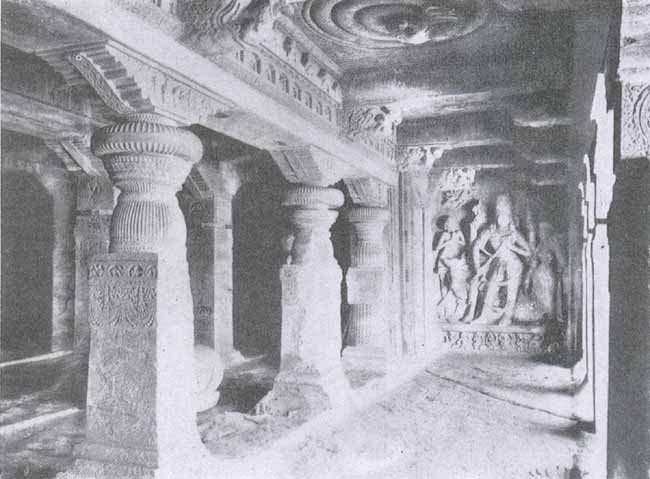
Cave temple, Badami
(Picture courtesy Archaeological Survey of India)
The temples at Aihole are closed square mandaps standing on a basement. They have a hall with four central pillars supporting a flat roof. The sloping periphery of the roof is supported on two rows of pillars, the one on the periphery shorter than the other. The space between the two rows of pillars is closed by perforated stone-slabs. The main mandap contains a Nandi. The flat roof has another shrine, the walls of which are made of slabs. The sloping roof helped to drain off the rain water.
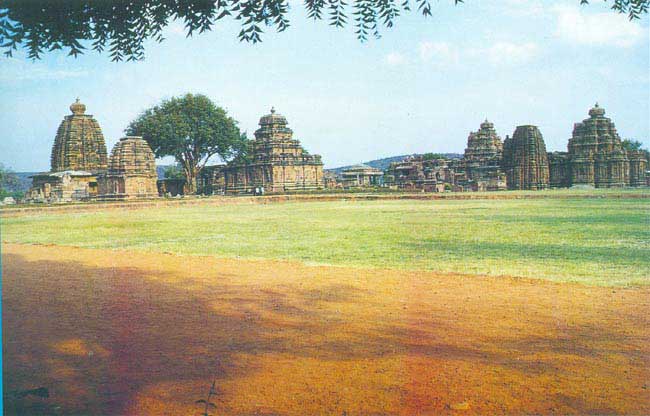
Virupaksha temple, Pattadakal
(Picture courtesy Archaeological Survey of India)
The Virupaksna temple at Pattadakal is the earliest temple complex of the Chalukyas. It consists of a high vimana, mandaps and smaller shrines around the courtyard enclosed by a wall. The front and rear walls have large gopura entrances. The smaller shrines are two-storeyed and have vaulted halls. The main square structure has a tall four-storeyed vimana. The mandapa pillars are richly sculptured. The temples at Pattadakal represent both the Northern and Southern style of architecture. .
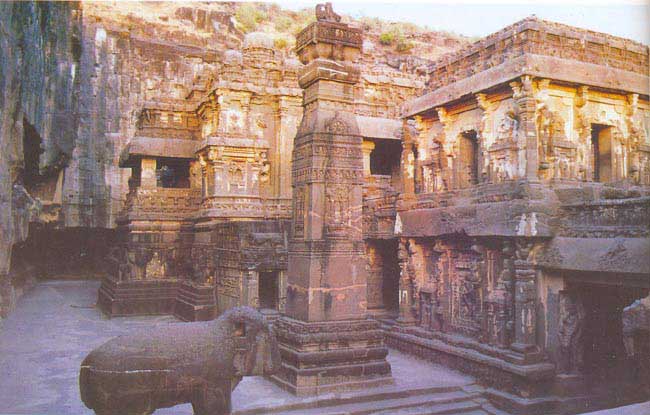
Cave Temple, Ellora
(Picture courtesy Archaeological Survey of India)
The large cave temples excavated by the early Chalukyas are located in Badami, Aihole, Ellora and in the Guntur and Krishna districts of Andhra Pradesh. Of the three brahmanical caves at Badami two are dedicated to Vishnu and one to Shiva. These temples consist of a rectangular pillared verandah, a square pillared hall with a small shrine cell at the back. Excavated in an axial plane, they have flat roofs like the mandapa type temples. Wide entrances, tall pillars with cushion type capitals supporting the roof and overhanging eaves are the main features of these cave temples. Figures of animals, humans and divine beings adorn the brackets.
The two cave temples at Aihole are dedicated to Shiva and have rock-cut lingas in them. The cave temples at Ellora are also dedicated to Shiva and contain images of Mahesa, Linga and Nandi. One of the caves is double-storeyed.
The cave temples in Andhra Pradesh contain relief sculptures of Ganesha, Brahma, Vishnu, Linga and Nandi.
RASHTRAKUTA ARCHITECTURE
The Dravidian or Pallava style was adopted by the Rashtrakuta Rulers also as can be seen in the famous Kailash Temple at Ellora near Aurangabad (Maharashtra). There are three groups of rock cut temples in Ellora – Buddhist, Jain and Brahmanical.
The Kailash Temple is a marvelous piece of rock architecture and sculpture. It was built by the Rashtrakuta King Krishna 1 in the 8th Century A.D. A complete hillside has been separated from a range of mountains and a huge temple excavated out of it. The main temple is supported on the backs of elephants. The Shikhara is elaborately carved. The temple has an entrance gateway, a Nandi shrine and five other shrines surrounding the courtyard. The main shrine has a large hall with beautifully carved pillars and a pyramidal Dravidian Shikhara. Beautiful sculptures of Hindu Gods and Goddesses, episodes from the Epics and Puranas adorn the temple. The Dasavatara gallery showing the ten incarnations of Vishnu is a masterpiece of architecture. There are a number of caves excavated from the hill sides around the temple which contain large halls with images of Hindu Gods.
Percy Brown says that the Kailash temple is “an illustration of one of those rare occasions when men’s minds, hearts and hands work in unison towards the consummation of a supreme ideal”.
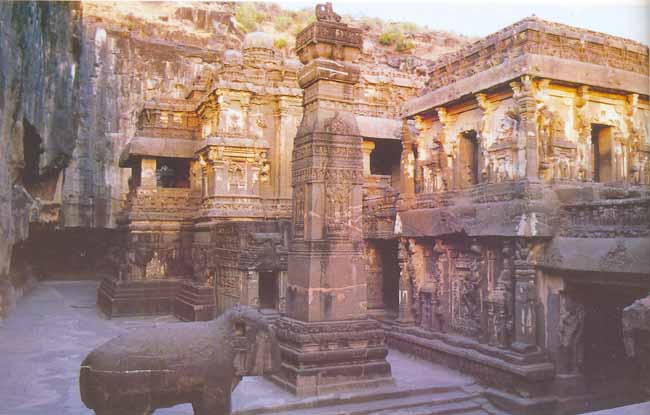
Kailasa Temple, Ellora
(Picture courtesy Archaeological Survey of India)
The cave temples on the island of Elephants near Bombay were also built by the Rashtrakuta Rulers. The main cave temple belonging to the brahminical group of cave temples is dedicated to Shiva and is noted for its fine sculpture. The temple has a large mandapa supported on twenty pillars on the periphery. Flights of steps lead to it from the courtyards in front and at the back. The temple is famous for the huge Trimurti depicting the three aspects of the Supreme Creator, Preserver and Destroyer. On the southern side is a smaller cave temple of Durga.
HOYSALA ARCHITECTURE
The Hoysala Rulers who succeeded the later Chalukyas and ruled over the Mysore Plateau in the 12th and 13th centuries A.D. were also lovers of art. They evolved a new style of architecture. The most notable temples of this period are those constructed in Belur, Halebid and Somnathpur. These temples are star-shaped. They are built on a high star-shaped base which is richly carved. The shikharas though pyramidal are low unlike those of other temples.
The Somnathpur temple was built by Vinaditya Ballal in about 1043 A.D. and is the earliest of this type. The temple though small was exquisitely carved with three pyramidal vimanas surmounting the three shrines. The best specimen of Hoysala art is the Hoysaleswara temple at Halebid and the Chenna Kesava temple at Belur.
The Hoysaleswara temple is composed of two similar temples side by side on a single five feet high star shaped terrace. Built of grey soap-stone, best suited for fine carving, each of the temples has star shaped vimanas with projections on three sides. The inner arms connect the two temples The mandapa ceilings and the pillars in the hall are intricately carved. The entire base is covered with running lengths of carved friezes of tigers, elephants, horses, birds and celestial beings-each frieze more beautiful than the other. The ceilings, interior and exterior walls of the temple have beautiful sculptures carved on them.
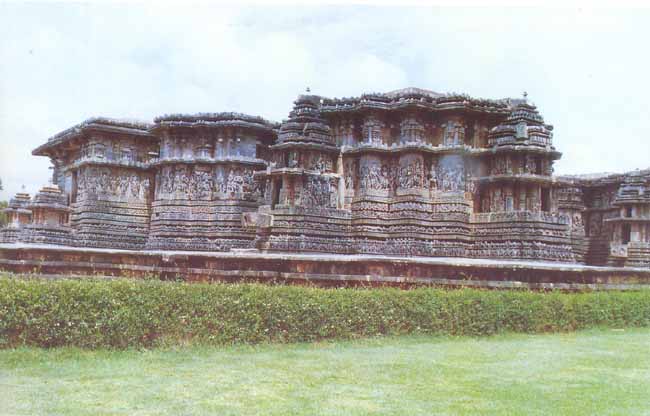
Hoysaleswara Temple Halebid
(Picture courtesy Archaeological Survey of India)
The Chenna Kesava temple at Belur was built by Vishnuvardhana of the Hoysala Dynasty in 1117 A.D. to commemorate a victory won over the Cholas at Talkad in 1116 A.D. It is dedicated to the deity Chenna Kesava. The temple stands in a spacious courtyard surrounded by a covered passage and compound with a gopura entrance. Later, other small temples were built in the courtyard around the main temple. The whole complex stands on a wide, raised star-shaped terrace with space enough for circumambulation. The star-shaped base has elephants in different poses adorning it The basement of the vimana is profusely carved with narrative friezes from the Ramayana, Mahabharata and Bhagavat Purana. The walls are covered with sculptures of miniature shrines, animated female figures and animals. The main entrances have a flight of steps from the courtyard and are flanked by two small vimanas. The ceiling and the pillars inside are elegantly carved. Bracket figures support the base of the ceiling: The superstructure on the main vimana is lost. Inside the sanctum sanctorum is the beautiful 2 meter high idol of Chenna Kesava.
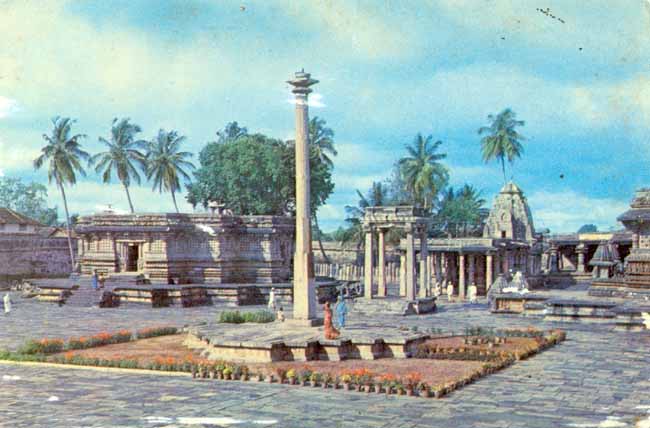
Chenna Kesava temple, Belur
(Picture courtesy Archaeological Survey of India)
The Ganga rulers whose kingdom included Mysore have left behind a group of stone Jain temples on the hills of Chandrigiri and Vindyagiri at Sravanabelgola in Hassan district of Karnataka. The most impressive of the monuments is the statue of Bahubali or Gomateswara, a Jain prince who after a victory in battle renounced worldly life for a life of meditation. Carved out of massive granite, the statue stands on the crest of the Vindyagiri hill. Standing nearly 20 meres high from head to foot, is of perfect proportions. It was erected by Chamundaraya, a minister of the Ganga ruler, Rachamalla in 974-984 A.D. The creepers entwining the limbs of the show him completely oblivious of life around. The statue is surrounded by a granite pillared cloister built by Gangaraja, a minister of the Hoysala ruler Vishnuvardhana.
No comments:
Post a Comment